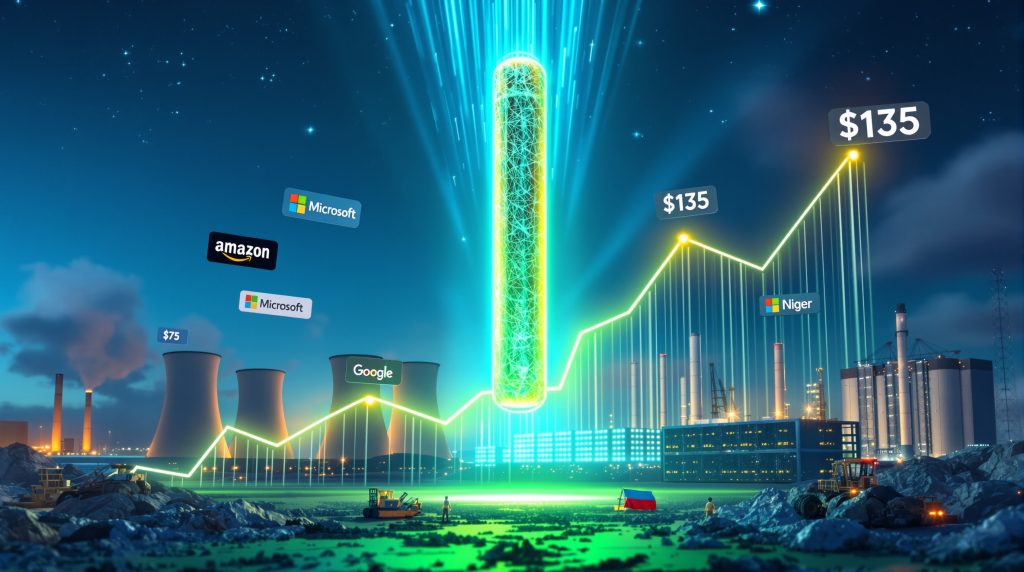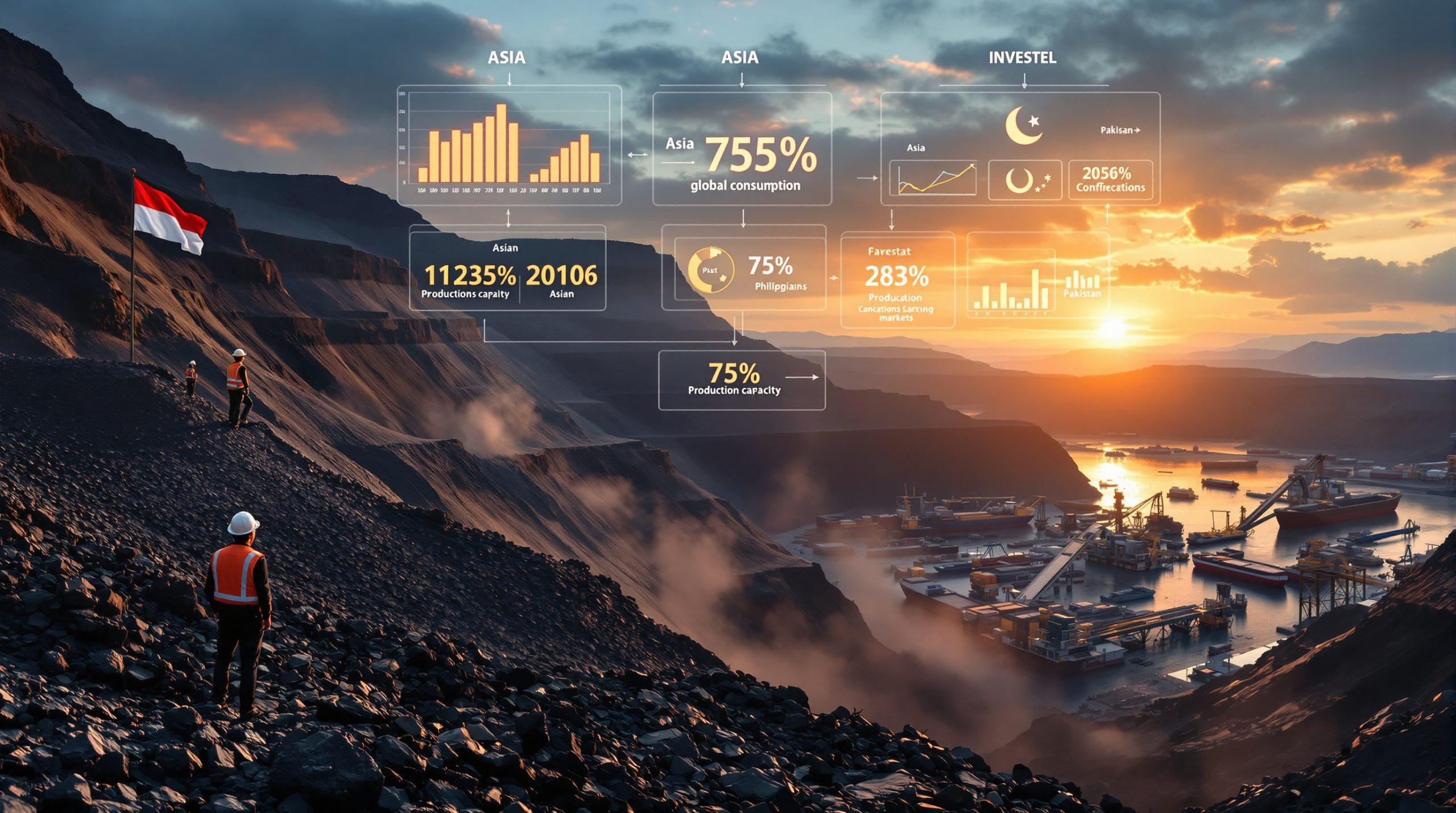Uranium Market Recovery: Understanding the 2025-2026 Price Outlook
The uranium market has experienced significant volatility throughout 2024, with prices rebounding from early-year lows of approximately $63 per pound to around $75 per pound as of August 2025. This recovery reflects a market finding its footing after a substantial correction that saw uranium equities decline by more than 50% from recent highs, returning valuations to levels not seen in several years.
Several key factors have contributed to this recovery, creating optimism among market participants. Supply disruptions from major producers have created market tightness, while renewed policy support for nuclear energy in major economies has bolstered confidence. Additionally, growing recognition of structural supply-demand imbalances and increasing interest from technology companies seeking carbon-free power sources have further supported the market.
The market's recovery trajectory began during Q2 2025, when uranium prices rebounded from March lows to the $70-71 range by early June. While spot prices have shown market volatility insights, long-term contract prices have remained remarkably stable around $80 per pound throughout the first half of 2025, demonstrating producer discipline and underlying confidence in market fundamentals.
Analyst Forecasts for Uranium Prices
Industry analysts have reached remarkable consensus regarding uranium's bullish outlook for 2025-2026, though specific price targets vary across different research institutions. The most bullish forecasts project uranium reaching approximately $135 per pound by 2026, driven by accelerating demand from nuclear reactor construction and constrained supply availability.
More conservative estimates still anticipate prices rebounding to the $90-100 range by mid-2025, with potential for additional upside if utility contracting accelerates beyond current expectations. These projections incorporate sophisticated modeling of utility contracting cycles, production capacity constraints, demand growth scenarios, and geopolitical factors affecting supply chains.
According to market data, Bank of America projects uranium prices to reach $90-100 per pound in 2025, potentially climbing to around $135 per pound by 2026, citing reactor construction and supply constraints as key drivers. Similarly, Carbon Credits forecasts prices in the $90-100 range for 2025, pointing to structural shortages and climate focus as supporting factors.
Ocean Wall analyst Ben Finegold predicts prices of $95-100 per pound in 2025, potentially moving "well over $100 per pound" in 2026, with tech sector demand and supply constraints driving the increase. BMO Capital Markets highlights 2.9% annual demand growth through 2035, while Trading Economics offers a more conservative 12-month forecast of $75.75 per pound.
Global Uranium Supply Pressures
The global uranium supply landscape faces unprecedented challenges that are fundamentally reshaping production dynamics and creating structural constraints that support higher prices.
Kazakhstan Production Challenges
Kazakhstan, accounting for approximately 40% of global uranium production, represents the most significant supply-side concern. The country's state-owned producer Kazatomprom has announced substantial production cuts that will reverberate throughout global markets, including a 12-17% reduction in 2025 production guidance due to critical shortages of sulfuric acid.
This represents an approximately 8 million pound reduction (about 5% of global primary supply) planned for 2026. Additionally, increased mineral extraction taxes beginning in 2025 are raising production costs significantly across Kazakhstan's uranium operations.
These production decisions reflect Kazatomprom's market-centric approach and assessment that current conditions don't warrant returning to full production capacity, despite stable long-term uranium prices around $80 per pound.
African Supply Disruptions
African uranium production faces its own set of constraints that further limit global supply. Niger's nationalization of Orano's uranium assets has eliminated a traditional supply source for European utilities, while resource nationalism is spreading across uranium-producing countries.
French mining company Orano has indicated it may close its SOMAIR mine in Niger due to export restrictions, further constraining available supply. The Paladin energy halt in Namibia has added to these disruptions. These geopolitical developments collectively limit supply options for Western utilities at a time when demand continues growing from both traditional nuclear power applications and emerging data center requirements.
North American Production Challenges
North American uranium production prospects present both opportunities and challenges for the market. Regulatory hurdles and permitting delays affect development timelines, while financing constraints may prevent timely capacity additions. Historical patterns of project delays and cost overruns continue to plague the sector.
Industry analysts have expressed skepticism about developers meeting projected timelines and budgets for new production capacity. The recent example of Peninsula Energy canceling contracts for 2 million pounds of uranium production demonstrates how supply-side disruptions can quickly tighten market conditions.
Tech Sector Demand Reshaping the Uranium Market
The uranium demand landscape has been fundamentally transformed by the emergence of technology giants as major consumers of nuclear-powered electricity, creating an entirely new demand category.
Amazon's Nuclear Initiatives
Amazon Web Services has established itself as a leading force through multiple nuclear power initiatives that directly impact uranium demand. The company has signed a 1.9 gigawatt purchase agreement through 2042 from Talen Energy's nuclear plant in Pennsylvania, backed by a $20 billion investment plan in regional data center facilities.
Amazon is also developing partnerships with nuclear developers to explore small modular reactor deployment near Virginia data centers, with a 5 gigawatt deployment plan targeted by 2040. These initiatives represent significant new demand for uranium fuel.
Microsoft's Nuclear Strategy
Microsoft's nuclear initiatives have garnered particular attention for their scope and ambition. The company has reached an agreement with Constellation Energy to restart Pennsylvania's Three Mile Island Unit 1 reactor, supported by a 20-year power purchase agreement delivering over 800 megawatts beginning in 2028.
Microsoft is also exploring small modular reactors and microreactors for its global network, with pilot projects scheduled for 2025. These initiatives signal a long-term commitment to nuclear energy that will support uranium demand.
Other Tech Giants Following Suit
Several other technology companies have announced nuclear energy initiatives that collectively represent substantial new uranium demand. Google has plans to procure nuclear energy sources for future data centers, while Meta has issued a request for proposals to secure 1-4 gigawatts of new nuclear capacity. Oracle is planning small modular reactor-powered data centers by 2030.
According to International Energy Agency projections, data center electricity consumption will reach 945 terawatt hours by 2030, roughly equivalent to Japan's entire current electricity usage. Industry analysis suggests nuclear energy could meet up to 10% of data center electricity demand by 2035, creating entirely new uranium consumption categories that weren't factored into previous market forecasts.
Policy Changes Affecting Uranium Markets
The geopolitical landscape surrounding uranium markets has undergone dramatic shifts that create both supply constraints and demand catalysts, further supporting price appreciation.
United States Policy Developments
Recent U.S. policy initiatives have established aggressive targets for domestic nuclear energy that will require substantially more uranium. The country has set a 400 gigawatt capacity target by 2050, representing a fourfold increase from the current 100 gigawatts of nuclear generation capacity.
This could potentially increase uranium demand from approximately 50 million pounds annually to nearly 200 million pounds. The recent US uranium import ban on Russian materials has further complicated supply chains. Regulatory streamlining for nuclear project approvals and domestic supply chain development initiatives further support this expansion.
The fast-tracked permitting processes now being implemented are already showing results, with Anfield Energy's Velvet-Wood project receiving approval in just 14 days, a timeline previously unheard of in the nuclear sector.
International Policy Shifts
Several international developments are reshaping global uranium markets and creating additional demand drivers. The Russia-Ukraine conflict has disrupted uranium enrichment and fuel supply chains, while European diversification efforts are moving away from Russian-controlled facilities.
India has announced ambitious expansion plans targeting nuclear capacity growth to 13 times current levels by 2047. Meanwhile, Chinese reactor construction continues to accelerate, driving the projected 2.9% annual uranium demand growth through 2035 cited by analysts.
These policy shifts collectively support higher uranium price forecasts across multiple time horizons as they create both supply constraints and demand catalysts in major markets.
Regional Variations in Uranium Markets
The regional dynamics of uranium markets reveal significant variations in supply security, pricing mechanisms, and strategic priorities that influence price formation.
North American Market Dynamics
North American uranium markets face particularly acute supply security challenges that support higher regional pricing. The United States consumes approximately 45 million pounds of uranium annually, yet domestic production covers only 1% of these requirements.
This heavy import dependence from geopolitically sensitive regions creates vulnerability, while Canadian production capabilities face development timeline challenges. Regulatory complexities extend project timelines beyond initial projections, further constraining domestic supply growth.
European Market Challenges
European uranium markets face their own set of regional challenges that influence pricing and supply security. Traditional African supply sources are increasingly constrained through resource nationalization, particularly with the loss of Niger's uranium production through nationalization of French mining operations.
European utilities have limited options for supply diversification as existing sources face challenges, and they increasingly must compete with Asian buyers for available supplies, creating price pressure.
Asian Market Growth
Asian uranium markets are characterized by rapidly growing demand that shapes regional pricing dynamics. China and India's nuclear expansion programs are creating regional competition for available supply, while Kazakhstan's dominant supplier position influences regional pricing structures.
The development of regional enrichment capabilities is altering traditional trade flows, while geographic proximity advantages benefit certain supply relationships. These factors create distinct regional pricing that may diverge from global benchmarks.
Changing Investment Patterns in Uranium Markets
The uranium investment landscape has undergone fundamental structural changes affecting both price discovery mechanisms and investment flows, adding complexity to market dynamics.
Physical Uranium Investment Vehicles
Institutional investment in physical uranium has altered traditional market dynamics by removing material quantities from commercial supply channels. The Sprott Physical Uranium Trust emerged as a major market participant, with physical purchases for investment purposes removing significant quantities from available supply.
The completion of a 2.5 million pound inventory purchase program represented a material reduction in spot market supply. However, reduced institutional buying pressure in recent months has contributed to price volatility as this demand driver temporarily moderated.
Retail Investor Participation
Retail investor participation in uranium markets has increased substantially, creating new market dynamics. Growing awareness of nuclear energy's role in climate solutions has attracted new participants, while expanded access through ETFs and mining equities has democratized uranium investing.
Social media information sharing about sector developments has accelerated knowledge transfer, though increased volatility from retail trading patterns adds complexity to price formation.
Production Company Strategies
Uranium producers have adapted their strategies to changing market conditions in ways that support price stability. Disciplined production approaches are maintaining supply constraints, while strategic inventory management helps optimize pricing across market cycles.
Long-term contracting preferences over spot market exposure provide revenue visibility, and vertical integration initiatives across the nuclear fuel cycle create operational efficiencies. These changing strategies influence how prices respond to market signals.
Long-Term Implications for Uranium Markets
The convergence of supply constraints, policy support, and unprecedented demand growth creates compelling long-term dynamics for uranium markets that extend beyond the immediate price forecasts.
Supply Development Timeline Challenges
The uranium supply response faces significant timeline challenges that will influence price formation. The industry typically requires a 7-10 year development cycle for new conventional uranium mines, with permitting and regulatory hurdles extending timelines even further in many jurisdictions.
Financing constraints limit capital allocation to new projects, while technical expertise shortages after years of industry contraction further complicate capacity expansion. These development timeline challenges suggest that supply responses will lag demand growth, potentially creating sustained price support through the latter half of the decade.
Nuclear Renaissance Sustainability
The sustainability of the current nuclear renaissance depends on several factors that will influence long-term uranium demand. Public perception of nuclear energy's safety and environmental benefits continues to improve, while regulatory stability across major nuclear markets provides investment confidence.
Cost competitiveness with alternative energy sources remains a focus area, though technological innovation in reactor designs and fuel cycles is enhancing economics. Industry analysts increasingly view the current nuclear renaissance as more sustainable than previous cycles due to climate imperatives, energy security concerns, and technological advancements.
Structural Market Changes
Several structural market changes support long-term bullish outlooks for uranium prices. The depletion of secondary supplies from weapons-grade material has removed a significant historical supply source, while consolidation of production capacity among fewer major producers enhances market discipline.
The integration of nuclear into clean energy portfolios globally creates stable demand growth, while the emergence of small modular reactors is creating entirely new demand categories not previously factored into market forecasts.
FAQ: Uranium Market Outlook
Will uranium prices exceed their all-time high of $148/lb from 2007?
While current analyst forecasts generally don't project prices reaching the all-time high of $148/lb in the immediate future, several factors could drive prices toward historical peaks by 2026-2027. These include accelerating utility contracting cycles, continued production discipline from major producers, faster-than-expected nuclear capacity expansion, and unexpected supply disruptions.
The fundamental drivers underpinning today's market appear more sustainable and broad-based than the speculative dynamics that characterized the mid-2000s price surge, potentially supporting sustained higher prices.
How will small modular reactor (SMR) development affect uranium demand?
Small modular reactor development is expected to create significant new uranium demand categories beginning in the latter half of this decade. Initial deployments are focused on remote applications and data centers, with standardized designs enabling faster regulatory approvals.
Lower capital costs are attracting new market participants, with potential for fleet deployments creating substantial demand growth. Industry analysts project SMRs could add 5-10 million pounds of annual uranium demand by 2030, with exponential growth potential beyond as deployment scales.
What impact will recycled nuclear fuel have on uranium markets?
Nuclear fuel recycling initiatives are gaining momentum but face significant timeline and scaling challenges that limit their near-term market impact. Commercial implementation remains limited to France, Russia, and Japan, while regulatory hurdles in Western markets slow adoption.
Economic viability depends on sustained high uranium prices, and technical challenges limit near-term displacement of primary production. Most industry forecasts suggest recycled fuel will offset less than 5% of primary uranium demand through 2030, limiting its impact on price formation during the current market cycle.
How might geopolitical developments affect uranium prices in 2025-2026?
Geopolitical factors represent both the greatest upside potential and downside risk to uranium price forecasts in the coming years. Sanctions affecting Russian nuclear fuel exports could create immediate supply shortages, while resource nationalism in producing countries may restrict export availability.
Tariff impact analysis suggests potential price volatility due to trade barriers. Nuclear cooperation agreements between consuming and producing nations could stabilize supply chains, though international tensions affecting uranium-producing regions could trigger price spikes. The market's sensitivity to geopolitical developments has increased substantially as supply chains tighten and inventory buffers diminish across the nuclear fuel cycle.
Uranium Market Outlook for 2025-2026
The uranium market stands at a pivotal juncture as multiple supportive factors converge to create what many analysts describe as one of the most compelling commodity investment opportunities in the energy sector. Current spot prices around $75 per pound represent just the beginning of what appears to be a sustained recovery trajectory, with consensus forecasts pointing toward $90-100 per pound by mid-2025 and potentially exceeding $135 per pound by 2026.
This price appreciation reflects fundamental market imbalances where global production meets only 80-90% of reactor requirements, creating structural deficits increasingly being filled through inventory drawdowns and spot market purchases. The unprecedented convergence of traditional utility demand growth, technology sector electricity requirements, and policy support for nuclear energy creates demand pressures that existing production capacity cannot satisfy without significant price incentives.
Supply-side constraints from production cuts in Kazakhstan, resource nationalism in Africa, and development timeline challenges in North America collectively suggest that market tightness will persist through 2025-2026 and potentially beyond. The emergence of technology giants as major consumers of nuclear-powered electricity represents a paradigm shift in demand patterns that traditional forecasting models are still adapting to incorporate effectively.
While short-term price volatility will likely continue as markets adjust to changing uranium investment trends, the underlying fundamental strength of uranium markets supports a bullish uranium price forecast across multiple time horizons. Investors, utilities, and policymakers should prepare for a sustained period of higher uranium prices as the global nuclear renaissance accelerates through the latter half of this decade, according to industry specialists at Sprott.
Disclaimer: This article contains forward-looking statements and forecasts about uranium market prices and industry trends. These projections are based on current market conditions and analyst opinions, which may change due to various factors including geopolitical events, regulatory changes, and market dynamics. Readers should conduct their own research and consult with financial advisors before making investment decisions based on this information.
Are You Positioned for the Next Major Uranium Discovery?
As the uranium market continues its recovery with projected prices reaching $90-135 per pound by 2026, savvy investors are turning to Discovery Alert's proprietary Discovery IQ model for real-time notifications on significant ASX uranium discoveries before the wider market reacts. Explore Discovery Alert's dedicated discoveries page to understand how early identification of major mineral finds can generate substantial returns during this nuclear renaissance.




